    
Tech833
Moderator
Username: Tech833
Post Number: 1707
Registered: 8-2002
| | Posted on Friday, September 19, 2008 - 12:18 pm: | 


|
According to FCC rules, anyone with a general or higher class amateur radio license may operate a beacon station.
So, what is a 'beacon' you ask? A beacon is a station that transmits signals for use in propagation studies, experiments, and other uses. A beacon does not receive, it just transmits. "Broadcasts' if you will. this is one of the rare exceptions on the ham bands for an unattended station that is broadcasting without making 2-way communications.
Most beacons are designed to provide information to fellow hams to determine if the band is open or not. If you want to shoot some HF DX, for example, you simply tune to the beacon segment of that band and scan around. If you hear one or more beacons, you can tell in an instant whether or not DX communications to that area would be possible at that moment. Some other hams use beacons as a means of making QSOs without actually having to do the talking (or keying) yourself. The IARU region 2 beacon coordinator's official list of 10 meter beacons is here- http://userpages.troycable.net/~wj5o/bcn.htm
So, what do most hams use for beacon equipment? There is no quick answer, as there is no standard setup. As you might be able to tell from the list, power levels and antenna choices are all over the spectrum. Even though the FCC allows up to 100 watts for an unattended beacon station, only one non- IARU beacon runs full power. Hams find it more useful if a beacon runs between 1 and 10 watts. The reason for this is that it is widely assumed that since most hams run 'barefoot', or 100 watts and SSB modes, the equivalent CW power level to 100 watts on SSB is 10 watts on CW. This is due to CW's ability to cut through when voice cannot. So it is easy to assume that if a 10-watt CW signal is getting from there to here, a 100-watt SSB signal would just the same.
At the 10-watt level, there are many choices for radios to convert to a beacon station. The now discontinued Radio Shack HTX-100 is the most popular, followed closely by the Lincoln 2510 and the Ranger 2950DX. Primary concern to the beacon builder, since 10 meter beacons operate in CW mode, is that the CW would be clean, and without 'chirp'. A chirping CW transmitter will raise eyebrows and draw unwanted attention, not to mention sounding terrible. Chirp is caused by the radio's oscillator section drifting in frequency as the transmitter is keyed. For example, the VR-9000 has chirp in CW mode, because the oscillator has to switch from the receive to transmit frequency as the radio is keyed on and off. The RF is envelope is produced just as the oscillator is stabilizing, and it sounds like a 'squish' instead of a 'beep'. This is easily fixed by keeping the VR-9000 mic keyed while operating CW with your key or keyer. That forces the oscillator to stay on transmit frequency and keeps it stable.
Of course, with any radio transmitter that is on the air almost continuously, cooling is a major concern. It is easy to dissipate the heat from one of the fore-mentioned radios with a simple cooling fan. But, once you get to higher power levels, that also means more heat to deal with. Few hams have the desire or technical ability to properly design a high power beacon station because of this and other issues that grow exponentially as power level goes up.
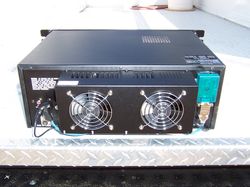
One of the secret gems that was previously unexplored is the possibility of using the Ranger RCI-2995DX as a full-power 10 meter beacon. First, for some reason, hams tend to steer clear of the 'export CB radio' line completely. I can only guess that there is some sort of stigma tied to the CB radio type equipment in legitimate ham use. Even having one of the 'export CB radios' in your shack is grounds for endless teasing from a fellow ham in most cases. This is completely uncalled for, in this writer's opinion. If hams were to put egos and preconceptions aside, they would discover an entire line of equipment that is not only up to the task for 10 and 12 meter communications, but easily affordable and tested in some of the most severe environments (trucks) and proven to be robust and a good value for performance.
Since this author has no ego or preconceptions, it seemed natural for me to use 'export CB radios' for my 10 meter beacon projects. Most of these radios are easily converted to such uses. I have also found that before 'modification', these radios will not go outside the ham bands, and therefore, should not pose a concern to those self-appointed 'ham cops' that tend to stick their noses where it does not belong. The RCI-2995DX covers the 10 and 12 meter hams bands, and nothing more, without modification.
So, steering back to the subject at hand, here is how I turned an RCI-2995DX into North America's only full-time, full-power 10m beacon.
Before beginning this project, my full-power 10m beacon consisted of an HTX-100 radio putting out 10 watts into an amplifier to produce a 100 watt output. This setup worked well for a long time, but took a LOT of rack space. Especially spatially inefficient was the amount of metal used to adequately heatsink the amplifier to keep it cool. I went in search of a smaller radio setup that would still be capable of 100 watts output continuous duty (broadcasting, if you will) and be reliable enough for a mountaintop installation.
Many weeks of research and questions later, the RCI-2995DX was chosen as a possible candidate. This was the choice narrowed down even after exploring more expensive options like the Icom 718 and Kenwood and Yaesu offerings. The 2995DX heatsink (and factory fabricated cooling fan option) were far superior to even the 'professional' gear I explored. Ranger recently changed their power supply in the 2995DX to a switching unit located internally to the radio with more than adequate capability for continuous operation. In this engineer's opinion, this was the stand-out choice.
The next step was to see one in person. This was not possible, so the only thing left was to take the plunge, and a gamble. A few emails with Copper Electronics later, one phone call, and an RCI-2995DX was on its way. The first thing noticed about the RCI-2995DX is that it is extremely well built. This is no cheap toy. The 2995DX cabinet feels more robust than a Kenwood or Yaesu. Performance wise, on CW the RCI-2995DX exhibits no 'chirp' and has a very stable output. It would make a great CW station for even the most serious ham! Adding a keyer and the optional fan kit is the only thing a beacon builder needs to turn an RCI-2995DX into a beacon transmitter. The RCI-2995DX even comes with rack ears to mount it in a standard 19 inch rack space. However, the RCI-2995DX does not use standard EIA rack spacing, it is an unusual vertical footprint in your rack, which makes leaving room around it almost compulsory by standardization alone. Using the 'AM PWR' adjustment inside the radio, it was easy to set the CW output power level to 100 watts.
My beacon keyer of choice is the PicCon, available in kit form and as a built-tested unit from Byonics. I like the PicCon because it is easily programmable, never loses its memory, is extremely reliable, and inexpensive. The PicCon is a really versatile unit, and using the PicCon as a CW beacon keyer only utilizes a small fraction of its capabilities. But, the PicCon handles the task with great ease and agility, and gives the ability to start on its own after a power failure, give any spacing between transmissions imaginable, a start-up delay after power failure, whatever your imagination could want.
Back to the RCI-2995DX project- The very first thing I decided had to be done was to eliminate the transmit/receive relay keying every time the radio sends a dit or dah. Hearing the two relays key and unkey hundreds of times each minute 24/7 would not provide very long life at all. I suspect they would be gone within a couple months of continuous beacon use. That was an easy 'fix' by just wiring a microphone connector to keep the radio keyed full-time. Even though the radio is in 'TX' mode all the time, it still will not put out RF until the CW key is closed. This is also an added bonus in that the oscillator is kept in transmit mode and would absolutely eliminate any possibility of CW 'chirp'.
My RCI-2995DX wasn't on the air long before I realized that the internal power supply was getting way too hot for its own good. Also, the internal aluminum chassis heatsink was burning hot to the touch (yes, I burned my finger on it). I needed to provide some airflow through the cabinet, and particularly to the power supply to keep this radio on the air. I found the switching power supply has its own internal fan, but no airflow holes in the cabinet were provided. See the following 'modifications' I did to the cabinet. The square series of holes in the top of the cabinet are right over the fan on the internal power supply. The fan blows air straight up and out of these holes. Of course, any time you have air going out, fresh air has to come in somewhere, and I wanted that air to flow over the aluminum internal heatsink to cool it as well. So, notice the holes along the side of the cabinet across that internal heatsink. Air comes in and flows across the internal heatsink, then through the power supply, then exhausts through the holes in the top of the cabinet. 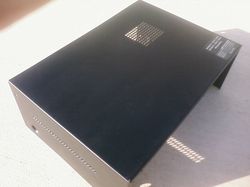
After reassembling the radio, it was installed in the shop and ran 24/7 without the air conditioning on. Temperatures in the building exceeded 100 degrees on a few occasions, thanks to the California summer. The RCI-2995DX never missed a beat. I was very eager to get the RCI-2995DX installed on the hilltop and on the air!
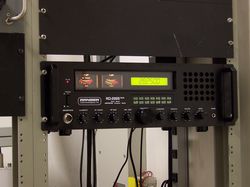
The RCI-2995DX has been on the air now for a month and a half, and so far, has been ideally stable and reliable. When I visit the site, I feel the cabinet and heatsink for signs of heat. Neither is ever a degree or two above room ambient temperature. The output from the RCI-2995DX sounds nice on the air with a very pleasant tone. Frequency drift has been less than 20 Hz. as the interior of the building warms up and cools each day. Overall drift has been less than 60 Hz. That is spectacular!
The RCI-2995DX can easily be set to any power level from 1 watt to the full legal limit for unattended beacons using a combination of internal and external controls. Also, the RCI-2995DX is built like an industrial machine, and lends itself well to continuous duty uses, like beacon operation. It is a natural choice for anyone with a 'no fooling around' attitude wanting to build a 10 meter beacon. When the band is open, tune in between 28.200 and 28.300 MHz. and you just might hear a Ranger RCI 2995DX representing the West coast of the United States to the rest of the DX world.
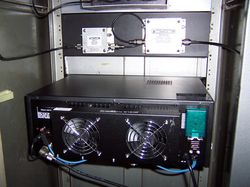 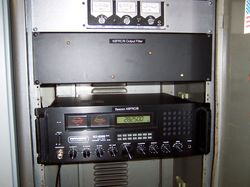 |



